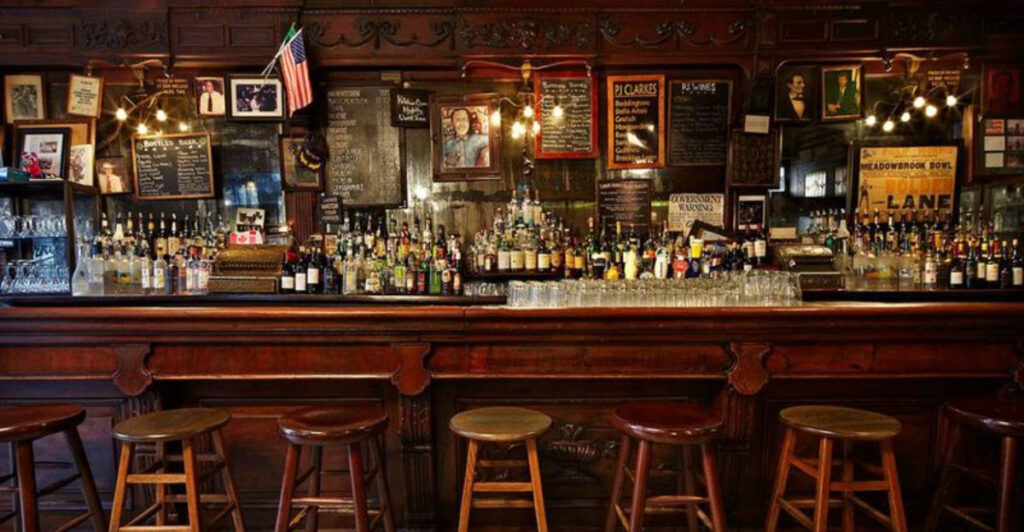New York City offers a rare chance to experience history through your taste buds. While skyscrapers rise and fall, some dining establishments have withstood the test of time for centuries. These culinary landmarks serve more than just food – they dish up fascinating stories from the city’s past with every meal.
1. Fraunces Tavern (1762): Revolutionary Dining

George Washington himself bid farewell to his officers within these historic walls. Established in 1762, this Lower Manhattan landmark continues serving traditional American fare while doubling as a museum filled with Revolutionary War artifacts.
The warm brick exterior welcomes visitors to step back into colonial America. Inside, wooden beams and period decor transport diners to the nation’s earliest days.
Order their famous pot pie or colonial-inspired porter ale while soaking in the atmosphere where American history was literally made. Few dining experiences offer such a direct connection to the founding of our nation.
2. Delmonico’s (1830): America’s Fine Dining Pioneer
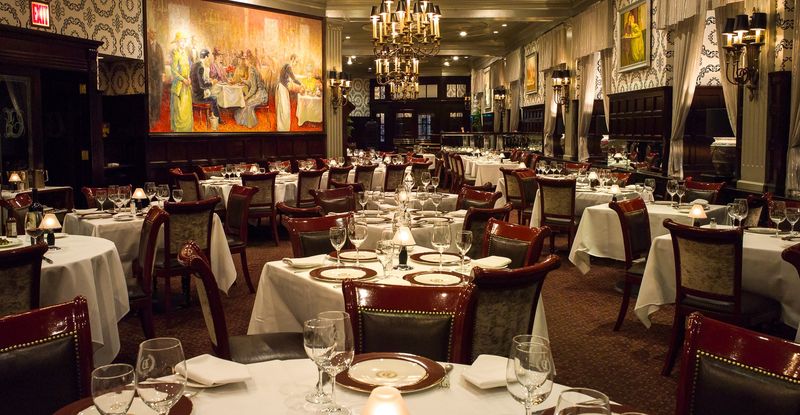
Credited as America’s first fine dining establishment, Delmonico’s transformed how Americans ate out. The Delmonico brothers introduced revolutionary concepts like printed menus, tablecloths, and trained waitstaff when they opened their doors in 1830.
Their signature Delmonico steak remains legendary nearly two centuries later. The restaurant claims to have invented Eggs Benedict, Baked Alaska, and Lobster Newburg – staples of American cuisine.
Walking into their elegant dining room feels like stepping into a more refined era. Dark wood paneling, brass fixtures, and white tablecloths maintain the sophisticated atmosphere that made Delmonico’s the blueprint for upscale restaurants nationwide.
3. McSorley’s Old Ale House (c.1854): Where Time Stands Still
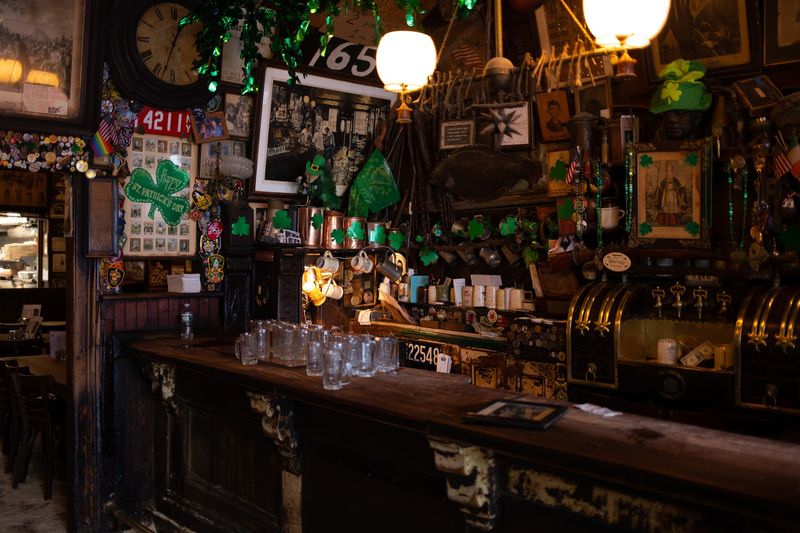
“We were here before you were born” proudly declares McSorley’s, NYC’s oldest continuously operating saloon. Founded around 1854, this East Village institution served only men until 1970 when a Supreme Court ruling finally allowed women inside.
Sawdust still covers the floors, and decades of memorabilia hang from every available surface. The menu remains stubbornly simple – light or dark ale served two mugs at a time, accompanied by saltines with cheese and raw onions.
Abraham Lincoln, John Lennon, and countless ordinary New Yorkers have all raised glasses here. The worn wooden bar, cast-iron stove, and original fixtures create a time capsule of old New York.
4. Keens Steakhouse (1885): Pipe Dreams and Prime Cuts
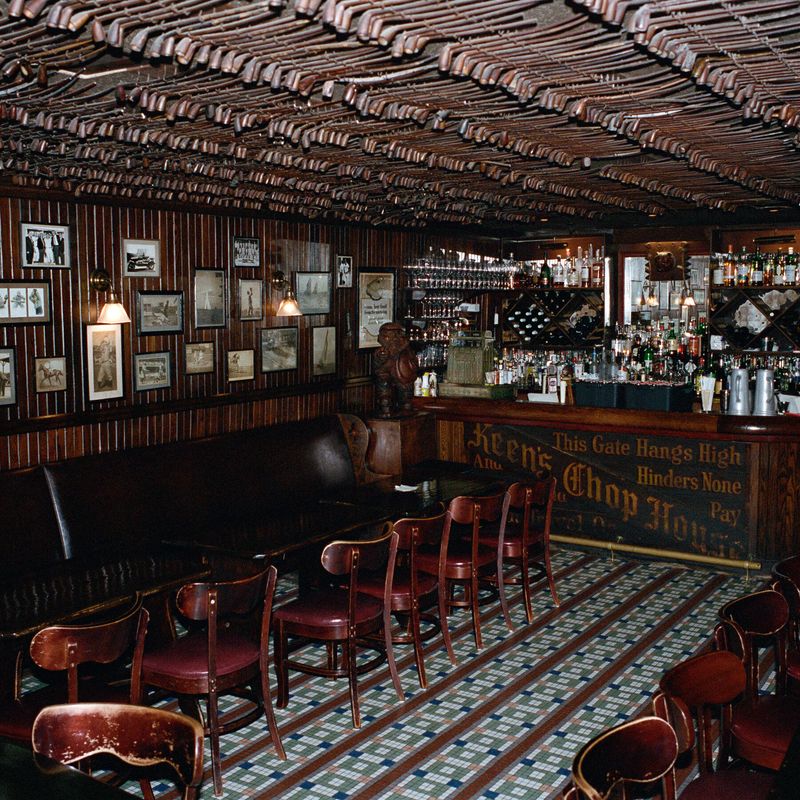
Look up at Keens and you’ll spot over 90,000 clay pipes hanging from the ceiling. Originally a gentlemen’s club where members stored personal pipes for smoking after dinner, this 1885 establishment houses the world’s largest clay pipe collection.
Abraham Lincoln’s pipe resides here alongside those belonging to Babe Ruth, Albert Einstein, and other historical figures. Their legendary mutton chop – actually a hefty, tender lamb chop – has remained the signature dish for over a century.
The mahogany bar, antique paintings, and theater memorabilia celebrate Keens’ location in the old theater district. Each dining room tells a different story of New York’s cultural history through carefully preserved artifacts.
5. P.J. Clarke’s (1884): The Cadillac of Burgers
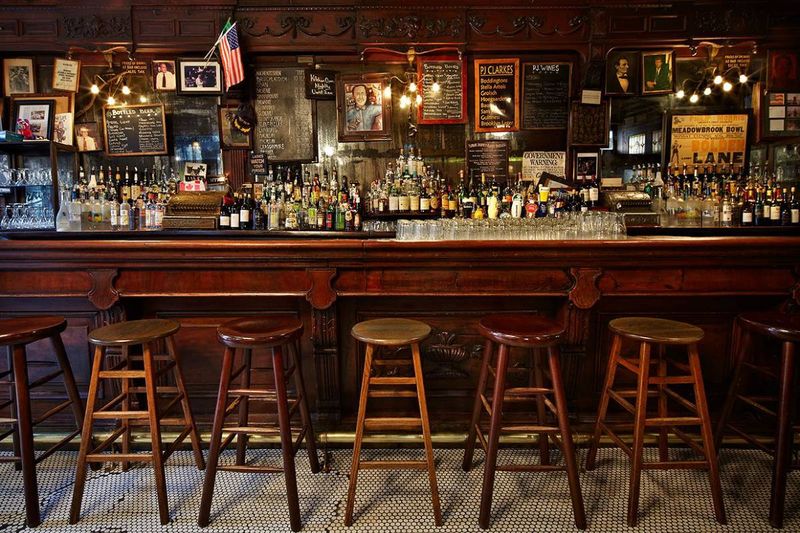
Frank Sinatra had his own table. Nat King Cole declared their burger “the Cadillac of burgers.” Since 1884, this unpretentious saloon has served comfort food to celebrities and locals alike from its distinctive red brick building.
Standing defiantly amid Midtown skyscrapers, P.J. Clarke’s refused to sell when developers bought surrounding properties. The original tile floor, mahogany bar, and bathroom fixtures remain virtually unchanged since the early 20th century.
Jackie Kennedy brought her children here for burgers. Buddy Holly proposed to his wife at table 53. While the menu has expanded beyond beer and burgers, the timeless atmosphere continues attracting those seeking authentic old New York charm.
6. Katz’s Delicatessen (1888): Where Harry Met Sally
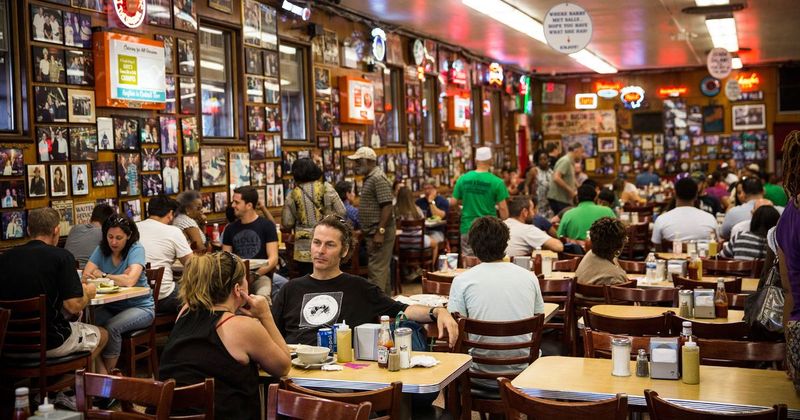
“Send a salami to your boy in the Army” – this WWII slogan helped make Katz’s a household name. Founded in 1888 by Jewish immigrants, this Lower East Side institution serves pastrami sandwiches so massive they’ve become the stuff of legend.
Each week, they hand-carve thousands of pounds of pastrami and corned beef using traditional methods. The meat is cured for weeks, then smoked and steamed for hours before being sliced to order by skilled carvers who often slip customers samples while they wait.
Famous for its role in “When Harry Met Sally” (yes, THAT scene), a sign now marks the very table. The cafeteria-style service, ticket system, and neon signs preserve the authentic deli experience of immigrant New York.
7. Lombardi’s Pizza (1905): America’s First Pizzeria

Coal-fired ovens roar at Lombardi’s, America’s first licensed pizzeria. Gennaro Lombardi opened his small grocery store in 1897, then began selling pizza in 1905, creating what would become New York’s signature dish.
The secret to their smoky, crisp-yet-chewy crust? The original coal oven reaches 800 degrees, creating the distinct char that defines authentic New York pizza. Their classic margherita uses simple, quality ingredients: San Marzano tomato sauce, fresh mozzarella, and basil.
After briefly closing in 1984, Lombardi’s reopened in 1994 just down the block from its original Little Italy location. Pizza lovers still line up daily to taste pizza made the same way it was when the concept first arrived with Italian immigrants over a century ago.
8. Nom Wah Tea Parlor (1920): Chinatown’s Dim Sum Legend
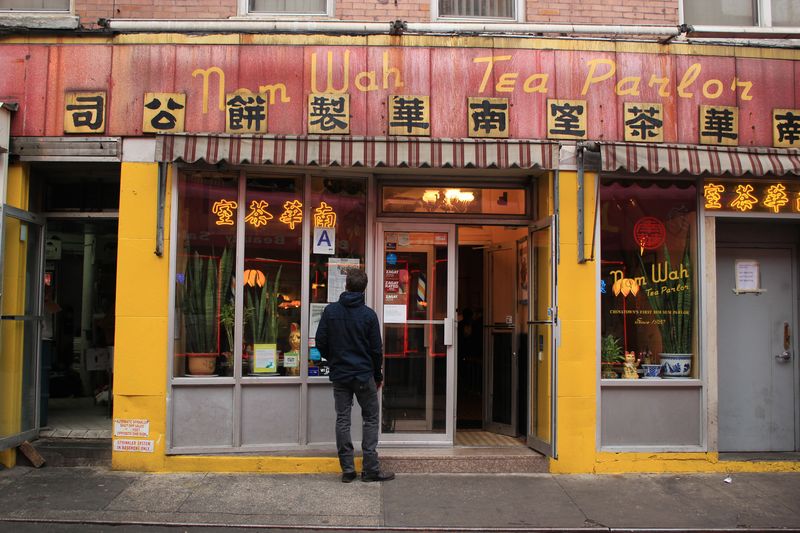
Red and yellow signs with Chinese characters mark Nom Wah Tea Parlor, Manhattan’s oldest continuously running dim sum restaurant. Opened in 1920 on the curved, narrow Doyers Street once known as “The Bloody Angle,” this eatery has survived Prohibition, gang wars, and decades of neighborhood changes.
Unlike modern dim sum palaces with rolling carts, Nom Wah uses a check-off menu system. Their vintage booths, tin ceiling, and retro counters remain largely unchanged since a 1950s renovation.
The egg rolls – made fresh daily with chicken and vegetables wrapped in thin egg crepe before being fried – follow the original recipe. Five generations of diners have enjoyed their renowned dim sum while sitting where their grandparents and great-grandparents once ate.
9. Bridge Café (1794): Waterfront History
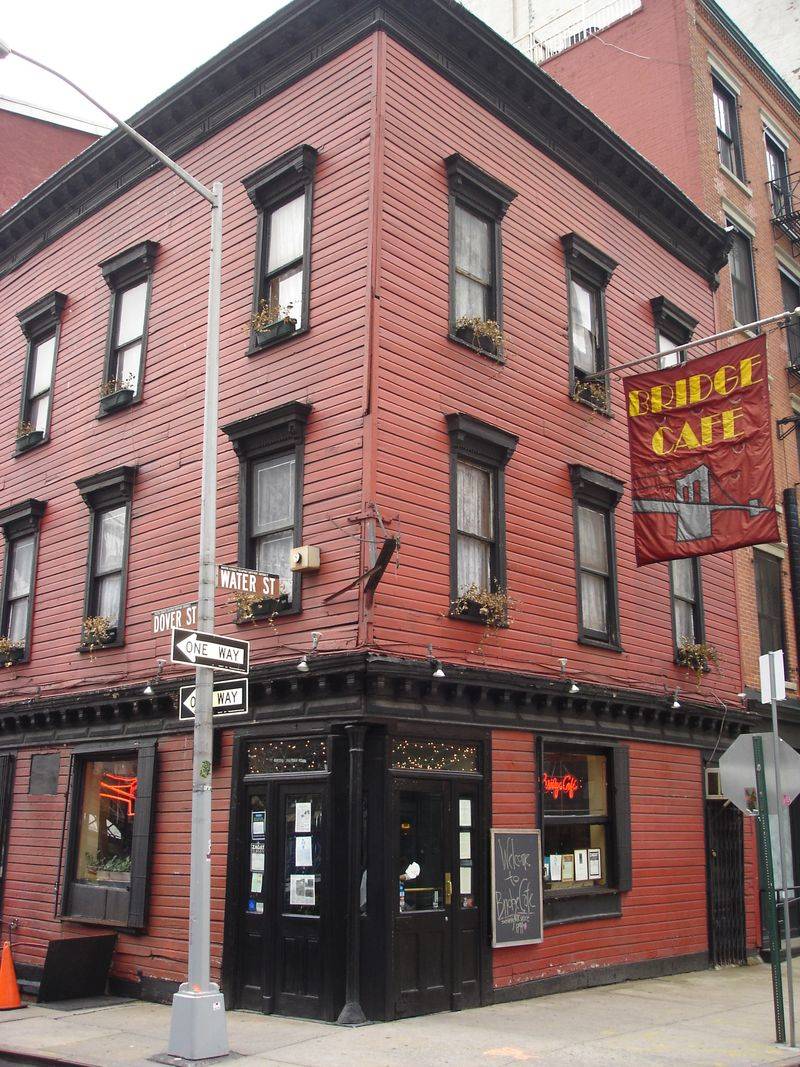
Sailors, dockworkers, and river pirates once frequented this humble wooden building near the Brooklyn Bridge. Established in 1794, Bridge Café operated as a grocery, brothel, and speakeasy before becoming a legitimate restaurant in the early 20th century.
The slanted floors and aged wooden beams reveal the building’s 18th-century origins. Situated in what was once the rough-and-tumble waterfront district, it claims to be the oldest drinking establishment in New York City.
Hurricane Sandy severely damaged the historic structure in 2012, forcing closure for repairs. Though its future remains uncertain, the red clapboard building stands as a rare survivor from New York’s earliest days, when the waterfront buzzed with maritime commerce and colorful characters.
10. Ear Inn (c.1817): Sailors’ Haven Turned Neighborhood Gem
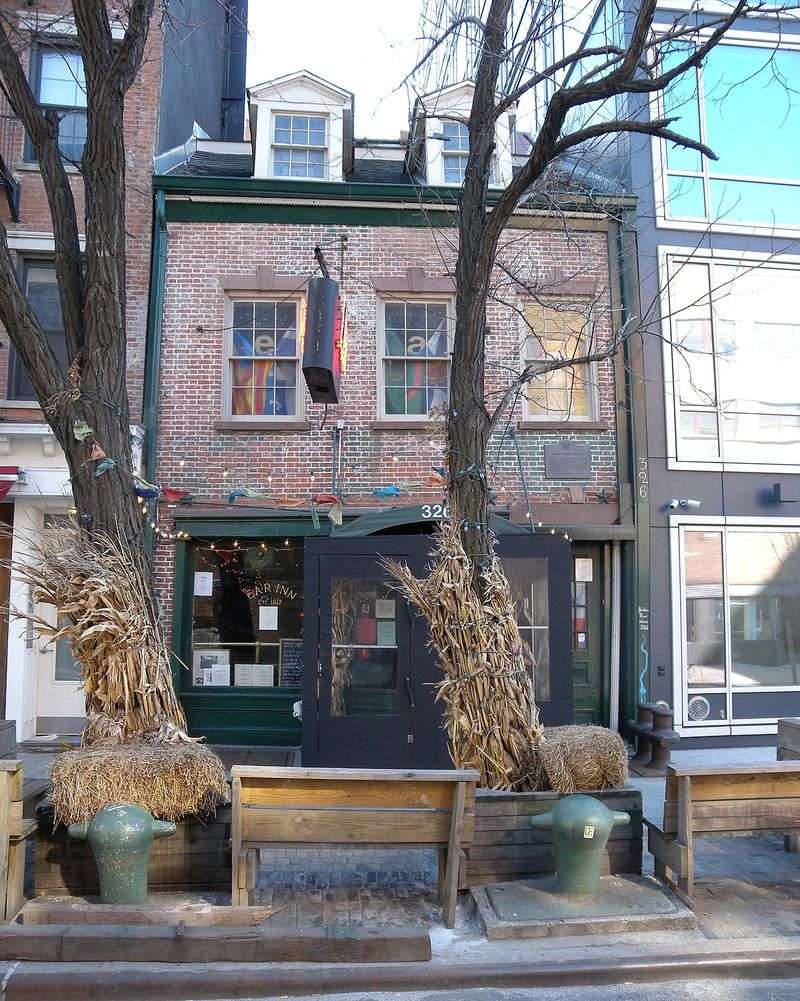
Originally built as a home for James Brown, an African American Revolutionary War veteran, this Federal-style building became a tavern serving sailors from nearby Hudson River docks around 1817. The clever name came in the 1970s when new owners modified the neon BAR sign to read EAR, avoiding landmark commission approval.
Ghost stories abound here – particularly of a sailor named Mickey who reportedly died in the building. The cozy, dark interior features original wooden beams, brick walls, and floors worn by two centuries of patrons.
Located in what’s now called SoHo, the Ear Inn serves straightforward pub fare alongside history. The building itself is listed on the National Register of Historic Places, making your burger and beer a genuine historical experience.

